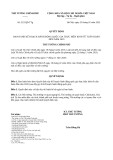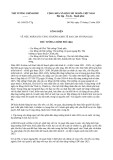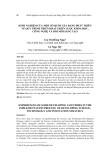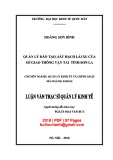CITRUS INSECT PEST AND THEIR CITRUS INSECT PEST AND THEIR NATURAL ENEMIES NATURAL ENEMIES
HoHoà
à VaênVaên ChieChieá
øngng, , Laâm Th
ác Cc Cööôôø
Nương Laâm Thịị MMỹỹ Nương
ánn,, Leâ Quo Leâ Quoá Southern Regional Plant Protection Southern Regional Plant Protection
Integrated pest Compiling based on Citrus pests and their natural enemies -- Integrated pest Compiling based on Citrus pests and their natural enemies Broadley management in Australia edited by Dan Smith, GAC Beattie & Roger Broadley management in Australia edited by Dan Smith, GAC Beattie & Roger
Leafminer (Phyllocnistis citrella Stainton)
1) symptom 1) symptom
Leafminer (Phyllocnistis citrella Stainton)
Leafminer
•Adult
Leafminer
Egg and larva
Leafminer
PupaPupa
Life Cycle
Eggs
First instar
Adult
Second instar
Pupa in pupal chamber
Pupa
Third instar
Pre-pupa
Leafminer (Phyllocnistis citrella Stainton) usually occur in the early rain season Leafminer usually occur in the early rain season Leafminer
and young shoot stage. and young shoot stage.
2). Life cycle 2). Life cycle The complete life cycle takes 14
17 days or The complete life cycle takes 14--17 days or times longer. times longer. Most adults live for less than a week, female Most adults live for less than a week, female moths start laying eggs about 24 hours after moths start laying eggs about 24 hours after mating. mating.
Leafminer (Phyllocnistis citrella Stainton)
Life cycle Life cycle Eggs are laid at night, a female can laid more than Eggs are laid at night, a female can laid more than 50 eggs their life (as many as 20 eggs per night). 50 eggs their life (as many as 20 eggs per night). The flat, slightly oval eggs are about 0.3 mm long The flat, slightly oval eggs are about 0.3 mm long and look like tiny water droplets on the leaves. Eggs and look like tiny water droplets on the leaves. Eggs are deposited singly, on the undersides of leaves are deposited singly, on the undersides of leaves near the midrib, usually at the base of the leaf. near the midrib, usually at the base of the leaf. 20 mm in length are preferred sites Young leaves 10--20 mm in length are preferred sites Young leaves 10 for egg laying. for egg laying.
Each pale
pupa and pupa are 6 days. The pre--pupa and pupa are
Larva stage is about 5
Leafminer (Phyllocnistis citrella Stainton) Hatching can occur within a day, and the young larva Hatching can occur within a day, and the young larva immediately burrows under the leaf surface. immediately burrows under the leaf surface. Each pale--green larva tunnels a characteristic, sinuous, green larva tunnels a characteristic, sinuous, like skin silvery mine in the leaf, with a raised parchment--like skin silvery mine in the leaf, with a raised parchment lined centrally with dark excreta. Larva never leave their lined centrally with dark excreta. Larva never leave their mines to form other mines or move between lower and mines to form other mines or move between lower and upper sides of leaves. Damage is caused by the larvae as upper sides of leaves. Damage is caused by the larvae as they mine immature foliage. Twisted and curled leaves are they mine immature foliage. Twisted and curled leaves are generally the first symptom noticed. generally the first symptom noticed. Larva stage is about 5--6 days. The pre about 6 days and then adults emerge. about 6 days and then adults emerge.
The leaves growth stages and their symptom The leaves growth stages and their symptom
Aphids Aphids sp.) ((Toxoptera Toxoptera sp.)
1) Symptom 1) Symptom
Aphids Aphids
aurantii Boyer de
Fonscolombe)) Boyer de Fonscolombe
((Toxoptera Toxoptera aurantii
Aphids are dark brown or black and about 2 mm long. Aphids are dark brown or black and about 2 mm long. They live on the young leaves and shoots with high They live on the young leaves and shoots with high density They feed on plant sap, using their sucking density They feed on plant sap, using their sucking mouthparts. They produce a sugary liquid (honeydew), on mouthparts. They produce a sugary liquid (honeydew), on which sooty mould grows, and can transmit plant viruses. which sooty mould grows, and can transmit plant viruses. Aphids may be winged or wingless, depending on the Aphids may be winged or wingless, depending on the state of their food supply and their density state of their food supply and their density Damage: deformation, flower drop, sooty mould, reduced Damage: deformation, flower drop, sooty mould, reduced fruit set, distortion of young leaves and shoots. fruit set, distortion of young leaves and shoots.
Aphids Aphids
2). Life cycle 2). Life cycle There are probably There are probably generations generations
2525--30 30 per years. per years.
wingless
Adult
virus virus
winged
nymph
Adult
The most important The most important known of vectors known of vectors to tristeza to tristeza is citrus plant. It citrus plant. It is very dangerous for very dangerous for citrus grower citrus grower
Whitefly Whitefly dispersus)) Aleurodicus dispersus ((Aleurodicus
1). Symptom 1). Symptom
Whitefly ((Aleurodicus Whitefly
dispersus)) Aleurodicus dispersus
Citrus whitefly usually occur on undersides of Citrus whitefly usually occur on undersides of young leaves , they are 2.5 mm long, with white young leaves , they are 2.5 mm long, with white powdery wings. Adult look like small moths, powdery wings. Adult look like small moths, they are related to scale insect. they are related to scale insect. Adult will fly out in swarms if foliage is Adult will fly out in swarms if foliage is disturbed. disturbed. shaped with The eggs are yellow and oval--shaped with The eggs are yellow and oval the young white powdery wax, underside the young white powdery wax, underside leaves or fruits, and circular egg laying pattern . leaves or fruits, and circular egg laying pattern .
Whitefly ((Aleurodicus Whitefly
dispersus)) Aleurodicus dispersus
2). Life cycle 2). Life cycle The larvae settle in group on the underside of The larvae settle in group on the underside of leaves . At first they are flat and resemble scale leaves . At first they are flat and resemble scale crawlers feeding and developing beneath a crawlers feeding and developing beneath a protective waxy covering. Both adults and nymphs protective waxy covering. Both adults and nymphs produce sticky honeydew on which sooty mould produce sticky honeydew on which sooty mould grows, and transmitting virus diseases. grows, and transmitting virus diseases. Three growth stages are followed by a pupa and Three growth stages are followed by a pupa and then winged adult. The pupae are often found on then winged adult. The pupae are often found on leaf midribs and look like young soft brown scale. leaf midribs and look like young soft brown scale. There are at least 5 to 6 generations per year. There are at least 5 to 6 generations per year.
Whitefly Whitefly
Citrus Hopper Citrus Hopper
Walker) peracutum Walker)
((Colgar Colgar peracutum
Citrus Hopper Citrus Hopper
Walker) peracutum Walker)
((Colgar Colgar peracutum 1). Shape and habits 1). Shape and habits Citrus Hopper
is about 10 mm long. When at rest their Citrus Hopper is about 10 mm long. When at rest their can occur on like shape. Citrus Hopper wings are tent--like shape. wings are tent Citrus Hopper can occur on mango also; mango also; They are pale green to white, with small red spot in the They are pale green to white, with small red spot in the middle of each forewing, and usually a red border on the middle of each forewing, and usually a red border on the forewings. Citrus Hopper are usually green, and covered with forewings. Citrus Hopper are usually green, and covered with . Both adult and larvae are mobile, small yellow spots. Both adult and larvae are mobile, small yellow spots skipping short distances when disturbed. Adult are weak skipping short distances when disturbed. Adult are weak fliers fliers
Citrus Hopper Citrus Hopper
Walker) peracutum Walker)
((Colgar Colgar peracutum
2). Life cycle 2). Life cycle The eggs of species are laid in oval shaped The eggs of species are laid in oval shaped masses about 50 eggs. The eggs masses are masses about 50 eggs. The eggs masses are about 5 mm in diameter. At first eggs are about 5 mm in diameter. At first eggs are white, but they darken near hatching. white, but they darken near hatching. Four growth stages are followed by adult. Four growth stages are followed by adult. The complete life cycle takes 1 to 2 months The complete life cycle takes 1 to 2 months There are about 3 to 6 generations per year. There are about 3 to 6 generations per year.
Citrus Hopper Citrus Hopper
2). Life cycle 2). Life cycle
citrus bug Spined citrus bug Spined Kirkaldy)) ((Rhynochocoris poseidon Kirkaldy Rhynochocoris poseidon
1). Shape and damage symptoms 1). Shape and damage symptoms spined citrus bug 15 20 mm long with a citrus bug 15--20 mm long with a
The The spined prominent spine on each shoulder of the prominent spine on each shoulder of the thorax. Both nymphs and adults of plant-- thorax. Both nymphs and adults of plant feeding species cause plant and fruit damage feeding species cause plant and fruit damage with their sucking mouthparts. The bug pierce with their sucking mouthparts. The bug pierce the rind of fruit at any stage causing drying the rind of fruit at any stage causing drying and brown staining of segments, gumming and and brown staining of segments, gumming and fruit drop. In ripe fruit, damage is often not fruit drop. In ripe fruit, damage is often not evident until the fruit is cut open. Young fruit evident until the fruit is cut open. Young fruit fall readily after attack. They can cause total fall readily after attack. They can cause total crop loss crop loss
citrus bug Spined citrus bug Spined ((Rhynochocoris Rhynochocoris Kirkaldy)) poseidon Kirkaldy poseidon
Damage symptoms Damage symptoms
citrus bug Spined citrus bug Spined Kirkaldy)) ((Rhynochocoris poseidon Kirkaldy Rhynochocoris poseidon
2). Life cycle 2). Life cycle
demoleus L.)L.) Citrus butterflies Citrus butterflies ((Papilio Papilio demoleus
1). Shape 1). Shape There are many species butterflies on citrus; the fully There are many species butterflies on citrus; the fully grown larva of the big citrus butterflies is 70 cm long(and grown larva of the big citrus butterflies is 70 cm long(and 50 cm for small one), they are brown to olive green in 50 cm for small one), they are brown to olive green in color, with a reddish band near the front. color, with a reddish band near the front. Larvae of both species have rows of small fleshy spines Larvae of both species have rows of small fleshy spines on the body. on the body. The big citrus butterfly has the wing span of about 130 The big citrus butterfly has the wing span of about 130 mm (75 cm for small one). Wings of the male are black mm (75 cm for small one). Wings of the male are black with white markings, while the hind wings of the female with white markings, while the hind wings of the female are brightly marked with white, orange and blue. are brightly marked with white, orange and blue.
Citrus butterflies Citrus butterflies demoleus L.)L.) ((Papilio Papilio demoleus
Adults
eggs
demoleus L.)L.)
Citrus butterflies Citrus butterflies ((Papilio Papilio demoleus
Larvae
Adult and pupa
demoleus L.)L.)
Citrus butterflies Citrus butterflies ((Papilio Papilio demoleus
The complete life cycle takes 2
2). Life cycle 2). Life cycle Butterfly lay eggs singly on the tip of the Butterfly lay eggs singly on the tip of the young leaves. The eggs of species are young leaves. The eggs of species are 2.5 mm in diameter. yellow, spherical and 2--2.5 mm in diameter. yellow, spherical and 2 The larvae pass through 5 instars, settle and The larvae pass through 5 instars, settle and feeding on young leaves before pupating in feeding on young leaves before pupating in an upright position attached to a citrus twig an upright position attached to a citrus twig by silken pad at the tail end, and a fine silken by silken pad at the tail end, and a fine silken girdle at the waist. girdle at the waist. The complete life cycle takes 2--3 months. 3 months. There are at least 3 generations per year. There are at least 3 generations per year.




































